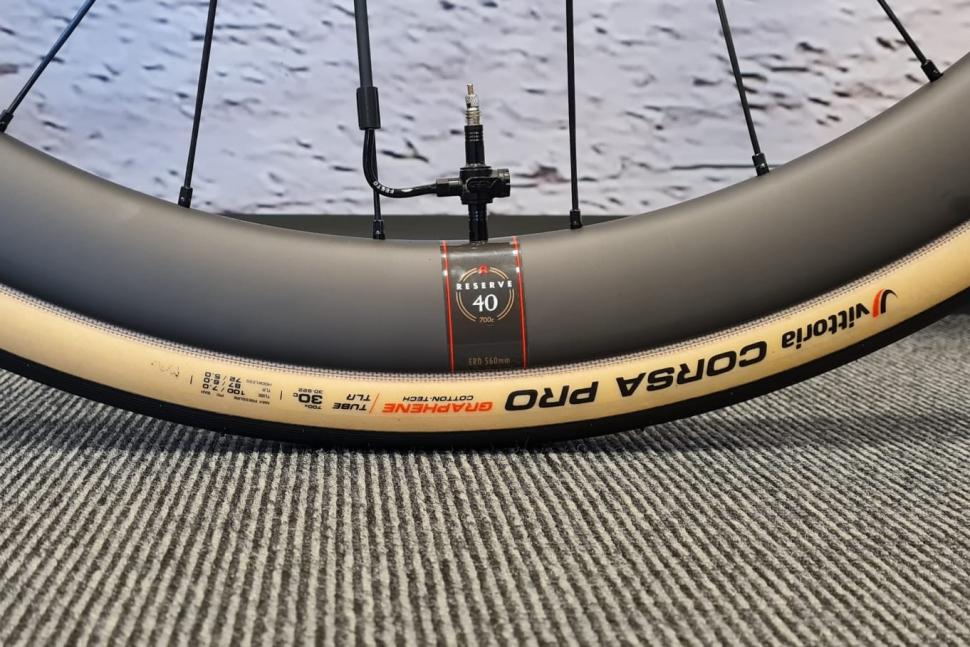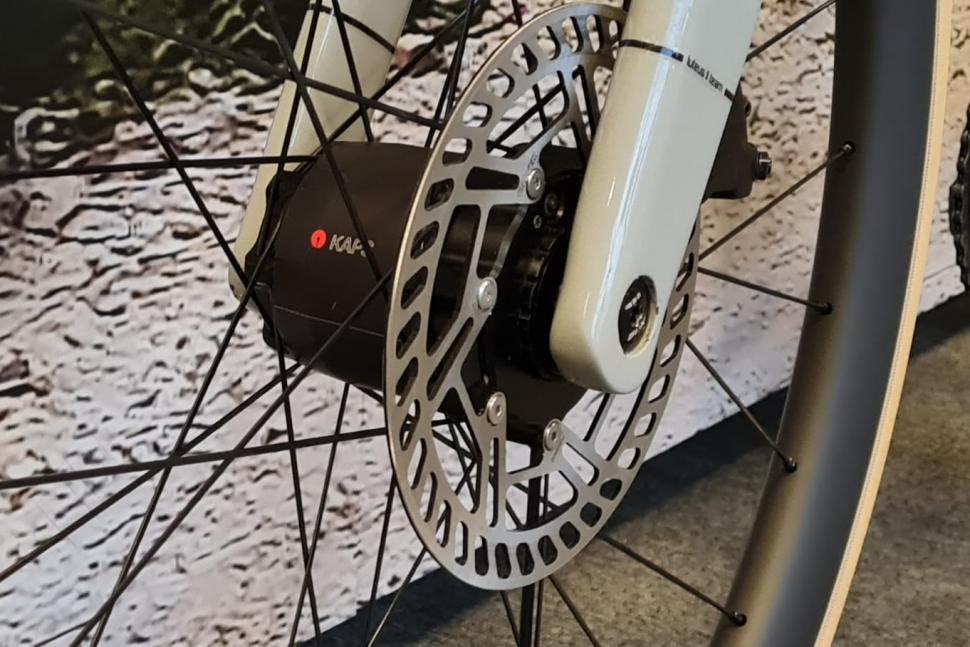- News
- Reviews
- Bikes
- Components
- Bar tape & grips
- Bottom brackets
- Brake & gear cables
- Brake & STI levers
- Brake pads & spares
- Brakes
- Cassettes & freewheels
- Chains
- Chainsets & chainrings
- Derailleurs - front
- Derailleurs - rear
- Forks
- Gear levers & shifters
- Groupsets
- Handlebars & extensions
- Headsets
- Hubs
- Inner tubes
- Pedals
- Quick releases & skewers
- Saddles
- Seatposts
- Stems
- Wheels
- Tyres
- Tubeless valves
- Accessories
- Accessories - misc
- Computer mounts
- Bags
- Bar ends
- Bike bags & cases
- Bottle cages
- Bottles
- Cameras
- Car racks
- Child seats
- Computers
- Glasses
- GPS units
- Helmets
- Lights - front
- Lights - rear
- Lights - sets
- Locks
- Mirrors
- Mudguards
- Racks
- Pumps & CO2 inflators
- Puncture kits
- Reflectives
- Smart watches
- Stands and racks
- Trailers
- Clothing
- Health, fitness and nutrition
- Tools and workshop
- Miscellaneous
- Buyers Guides
- Features
- Forum
- Recommends
- Podcast
TECH NEWS
 2023 Gravaa KAPS - 1
2023 Gravaa KAPS - 1On-the-fly tyre pressure adjustment appears on Dwars door Vlaanderen cobbles
Team Jumbo-Visma’s Edoardo Affini is racing today’s Dwars door Vlaanderen semi-classic using the Gravaa KAPS system that allows on-the-fly tyre pressure changes. Could its use over the cobbles indicate that Jumbo-Visma is considering using the tech in Sunday’s Tour of Flanders and/or in Paris-Roubaix the following weekend? It's certainly possible.
👀 Looks like Affini is testing the KAPS adjustable air pressure system. #DDV23 #DDV pic.twitter.com/myK3cltMrF
— Janus (@JVerlaeckt) March 29, 2023
We reported last year that Team DSM was experimenting with Scope Atmoz hubs that allow the rider to adjust tyre pressure while riding via a button on the handlebar. That’s an entirely different system but it looks like the idea is taking hold in the pro peloton with Edoardo Affini’s bike spotted with Gravaa’s set-up today.
What’s the point? If you’ve ever ridden on cobbles, you’ll know. They can knock you about all over the place, leading to many crashes – especially the brutal cobbles found in Paris-Roubaix. Plus, Gravaa argues that “there is a significant increase of rolling resistance on cobblestones upon higher tyre pressures”. More on that below.
In an ideal world, riders want higher tyre pressures on the tarmac and lower pressures for increased comfort and control across the cobbled sectors, but getting a single set-up that can deliver both hasn’t been possible until very recently.
Gravaa, based in the Netherlands, allows you to regulate your tyre pressure while riding via a pump that’s integrated into the hubs.
Gravaa calls the tech its Kinetic Air Pressure System (KAPS). KAPS allows you to control the pressure both up and down via a wireless control unit mounted to the handlebar.
The system uses what Gravaa describes as “a miniature reciprocal membrane pump”.
“The pump cylinders are moved by a camshaft, which is driven by the rotation of the wheels: powered by you,” says Gravaa. “The pump is the heart of our system.
“The pump consumes only a little energy when switched on. To limit this amount of energy required to inflate your tyres even further, the pump is (automatically) switched on/off for you via a pneumatic clutch unit. This clutch is actuated via a pneumatic membrane and the pressure inside your tyre is also used to (de)activate the clutch.”
“The complete system is driven by human power, but our ultra-low-power electronics allow for communication with and control of our system. Hardware and software design choices are all driven by function and low-power usage. Each hub has a rechargeable battery inside, which can be charged via USB chargers.”
Based on testing on the Camphin-en-Pévèle cobbled sector of Paris-Roubaix, Gravaa says, “The rolling resistance when entering a cobblestone section is very high. Rolling resistance suddenly becomes the dominant power loss factor. For instance, at high speeds (>35 km/h), the differences between cobbles and tarmac can easily exceed 150 W to maintain that speed.
“Setting for a fixed tyre pressure of 4.5 bar during Paris-Roubaix, each cobblestone section gets penalised by more than 30 W for the elite women, and potentially by more than 50 W for the elite men – depending on rider weight and riding speed – compared to the optimal (low) tyre pressure at the cobblestone sections. On tarmac, the penalty is less, but still there.
“Considering the complete Paris-Roubaix course, our KAPS technology can give a power advantage of about 20 W overall, and a peak power advantage of about 60 W, by simply adjusting the tyre pressure to the surface while riding. The advantage of 60W will be true for the most difficult cobblestone sections. On top of this comes the better handling of the bike, more grip, more comfort, and the reduction of incidents (punctures, falling). This easily compensates for the weight penalty of 250 grams per hub and (relatively small) power consumption when the pump inside the hub is active (during inflation only).”
The Gravaa R-40/44 wheels, resulting from a partnership with Reserve Wheels and DT Swiss, are priced €4,299 (around £3,790). It looks like these are the wheels that Edoardo Affini is using in Dwars door Vlaanderen.
How likely are we to see the wheels used in Paris-Roubaix?
Gravaa says, “The KAPS technology is all about winning this race,” so we guess it all depends on how things go today.
It's a bicycle arms race out there on the pavé which does make you wonder how the UCI views this technology, given this is an organisation that has issues about sock lengths and glucose monitors.
The UCI’s line on technical innovation is: “Except in mountain bike racing, no technical innovation regarding anything used, worn or carried by any rider or license holder during a competition (bicycles, equipment mounted on them, accessories, helmets, clothing, means of communication, telemetry device, sensors, etc.) may be used until approved by the UCI.”
The UCI did last year approve the Scope Atmoz hubs mentioned above so we’re assuming it’s cool with the Gravaa KAPS too.
Get more info over at www.gravaa.com
The more eagle-eyed among you will have spotted that the tubeless tyre on the Gravaa wheel at the top of the page is the unreleased Vittoria Corsa Pro that's seeing plenty of action in the peloton right now. It's actually the clearest pic we've seen so far. Expect a launch within the next few weeks.
Mat has been in cycling media since 1996, on titles including BikeRadar, Total Bike, Total Mountain Bike, What Mountain Bike and Mountain Biking UK, and he has been editor of 220 Triathlon and Cycling Plus. Mat has been road.cc technical editor for over a decade, testing bikes, fettling the latest kit, and trying out the most up-to-the-minute clothing. He has won his category in Ironman UK 70.3 and finished on the podium in both marathons he has run. Mat is a Cambridge graduate who did a post-grad in magazine journalism, and he is a winner of the Cycling Media Award for Specialist Online Writer. Now over 50, he's riding road and gravel bikes most days for fun and fitness rather than training for competitions.
Latest Comments
- brooksby 17 min 30 sec ago
I had to walk past my old stomping ground on Park Row the other day, which is the western end of this same scheme (Marlborough Street by the BRI,...
- brooksby 21 min 46 sec ago
Or turning that on its head: the aforementioned paint can can cause harm if it is *accidentally* damaged or is otherwise used in a way for which it...
- eburtthebike 4 hours 49 min ago
A comedian with a purpose can achieve more than the politicians e.g. Zelesky.
- Hirsute 6 hours 25 min ago
Sounds a bit specific though given 90% are bought on some sort of finance.
- Rekrab 6 hours 43 min ago
MORE LANES, MORE LANES!!!!
- Simon E 6 hours 50 min ago
The numbers don't tell anything like the whole story....
- David9694 8 hours 1 min ago
check under 'W'for "What cars do to people"
- Global Nomad 8 hours 42 min ago
good to see you're testing the farsports wheels - hope to see road.cc continue to expand the range of brands it considers. These or the shallower...
- chrisotherwise 9 hours 16 min ago
Sadly very normal. And the sand contains loads of evil little shards of flint.


Add new comment
6 comments
I wonder if you could use this to copensate for a puncture by leaving the pump on all the time??
It says on their website "Small leakages can be sustained by continuously adding air via our patented kinetic air pressure system (KAPS)" so for a slow puncture, basically yes, one assumes.
This could take all the fun out of the cobbles...
How are they going to fit this AND a Classified hub to WVA's bike?
I didn't know WVA had run a classified hub. Are there plans for him to run one?
In fact, a quick look at Classified website and Reserve wheels are not listed as a partner, so don't see anyone on Jumbo running a Classified hub.
No, he ran a single front setup at Milan-San Remo but no Classified. As far as I know Campenaerts is the only World Tour rider thus far to have used a Classified hub in a race, at this year's Omloop Het Nieuwsblad.